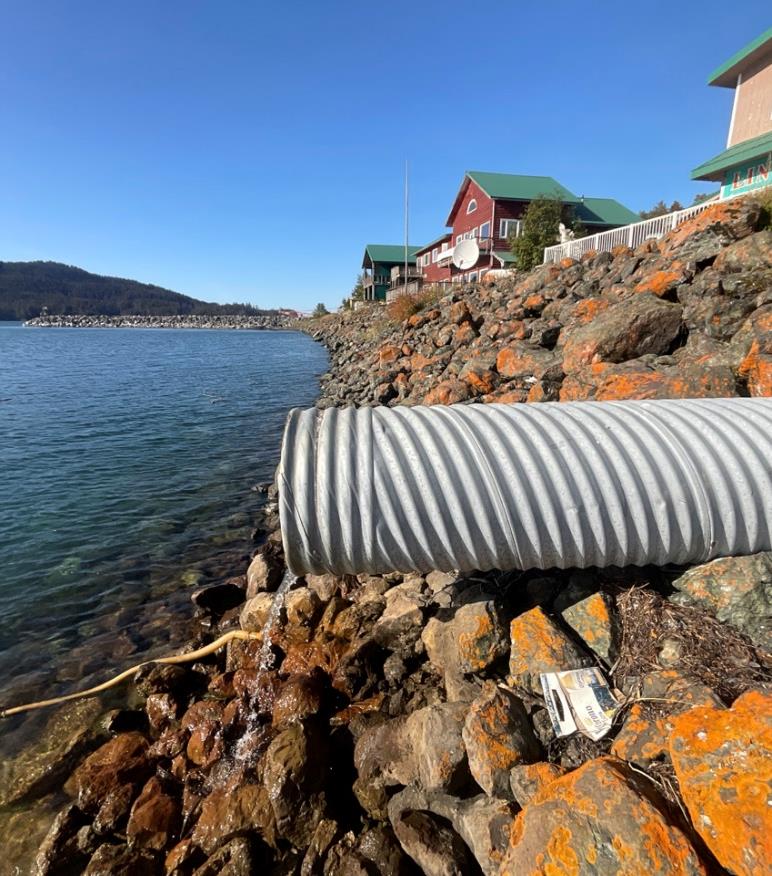A Model for Small Alaskan Communities: Seldovia’s Stormwater Strategy
Written by Jeff Fisher, DEC
December 18, 2025
In the small coastal Alaska community of Seldovia, a multi-phase project is underway to better understand and manage how stormwater moves across the community’s streets and into the waters of Seldovia Bay. This work implements a priority identified in Alaska’s Nonpoint Source Water Pollution Prevention and Restoration Management Plan, helping protect the health of local waterways and the habitats and activities they sustain. Funding for these projects was made possible through DEC’s Alaska Clean Water Actions (ACWA) grant program. Seldovia was awarded funds in both the 2023/2025 and the 2025/2027 grant cycles.
With the support of 2023/2025 ACWA funds, the City of Seldovia mapped its drainage systems and conducted a comprehensive drainage study. This included calculating stormwater design events and identifying the types and amounts of nonpoint source pollution, like sediment and debris, that reach nearby streams and bays. Crews inventoried city streets, storm drains, and culverts, noting where improvements are needed to help water move more efficiently through the community.

Drone imagery of Seldovia showing how interconnected Seldovia is with the waterways that are in and around the coastal community. Photo by DEC staff.
Building on these findings, the City of Seldovia created a Stormwater Management Plan, outlining practical steps to slow and filter runoff before it reaches sensitive waterbodies. Recommended actions include adding features that allow water to settle and infiltrate into the ground, updating existing infrastructure, and planning for stormwater resilience in future development. This stormwater management plan acts as a guidance for planning and future development aimed at enhancing the water quality of stormwater runoff into Seldovia Bay.
Seldovia City Manager Heidi Geagel describes the community as small yet mighty. Like many remote communities, however, limited staff and resources can constrain what the city is able to take on at scale. “A lack of time, budget, and equipment made completing a stormwater management plan in house nearly impossible,” said Geagel. “Completing the plan with professional support resulted in a stronger foundation for both larger projects and day-to-day stormwater maintenance, which will benefit the community for generations to come.”

Stormwater flows out of an outflow pipe into Seldovia Bay. Photo by City of Seldovia.
During the current grant cycle, the city of Seldovia is building on the momentum from their previous work by contracting with engineering and construction firms to design and implement drainage improvements along Vista Avenue, Frank Raby Drive, and Main Street near the Harbor Pavilion and boat ramp. New culverts, regrading, and regular street-sweeping (currently limited to one time per year), made possible with new street sweeper equipment attachments purchased using ACWA funds, will all contribute to reducing sediment and associated pollutants from draining into Seldovia bay. These efforts will help ensure that Seldovia Bay is clean and healthy for generations of Alaskans to come.
DEC’s Nonpoint Source Water Quality section manager Laura Eldred is excited to support the City of Seldovia for a second ACWA grant cycle as city leaders work towards better understanding their storm drainage patterns and develop solutions for problem areas that may affect the community’s water quality. “Implementing actions in the newly developed Watershed Management Plan have a positive effect on water quality within the Seldovia Creek watershed and Seldovia Bay,” said Eldred.
The City of Seldovia Stormwater Management Plan can be found on DEC’s water quality website by searching the water quality reports inventory list. Once this grant cycle’s work is complete, project reports will be available on DEC’s water quality website as well.

 Indicates an external site.
Indicates an external site.